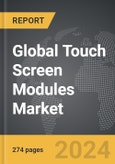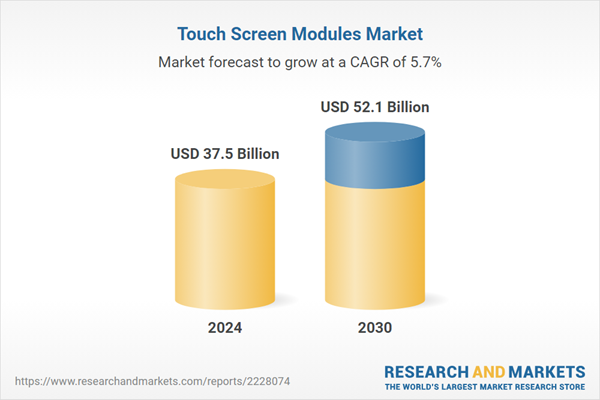The global market for Touch Screen Modules was valued at US$37.5 Billion in 2024 and is projected to reach US$52.1 Billion by 2030, growing at a CAGR of 5.7% from 2024 to 2030. This comprehensive report provides an in-depth analysis of market trends, drivers, and forecasts, helping you make informed business decisions.
The evolution of touch screen technology is marked by several significant trends. Integration of artificial intelligence (AI) and machine learning (ML) optimizes user interactions and adapts interfaces based on user behavior. Improvements in durability and reliability are making touch screens more resilient to environmental challenges and extensive use. Innovations in gesture and pressure interpretation are enhancing the depth of interaction, while touch screens are becoming gateways to broader smart device ecosystems, connecting users with various Internet of Things (IoT) applications. New display technologies are expanding possibilities for innovative device designs and applications, ensuring that touch screens continue to evolve and meet the diverse needs of modern users.
Touch screen modules have become integral to modern technology, transforming the way individuals interact with devices across various sectors. These modules consist of a touch sensor layer, controller IC, driver software, and display panel, collectively converting physical touches into actionable digital commands. Different types of touch screen technologies cater to specific applications: resistive screens offer durability and affordability, capacitive screens provide sensitivity and multi-touch support for consumer devices, surface acoustic wave (SAW) screens ensure high clarity for precision environments, infrared (IR) screens are ideal for use with gloves in outdoor settings, and optical screens are commonly used in large-format displays. Touch screens are ubiquitous in smartphones, tablets, vehicles, industrial machinery, self-service kiosks, and medical devices, enhancing functionality, user experience, and accessibility.
Global Touch Screen Modules Market - Key Trends and Drivers Summarized
Key growth drivers for the touch screen module market include increasing consumer demand for intuitive interfaces in everyday devices and other areas such as automotive and home appliances. Enhanced accessibility features facilitate easier interaction for people with disabilities, making technology more inclusive. In automotive and industrial applications, touch screens improve safety by reducing the need for physical buttons and switches, allowing users to focus more on primary tasks. The integration of personalized user data creates tailored experiences, particularly in vehicles where settings can adjust automatically based on the driver's preferences. The retail and hospitality sectors are adopting touch screen modules in self-service kiosks and digital ordering systems, enhancing consumer engagement and operational efficiency. Additionally, educational and professional training environments are using touch screen technology to make learning more interactive and engaging, driving demand for large touch screen panels. The proliferation of smart home technologies further boosts demand for user-friendly and responsive touch screen interfaces for managing and controlling various smart devices. These factors underscore the expanding role of touch screen modules in various aspects of daily life and work, highlighting their growing importance and the continuous innovation driving the future of human-computer interaction.The evolution of touch screen technology is marked by several significant trends. Integration of artificial intelligence (AI) and machine learning (ML) optimizes user interactions and adapts interfaces based on user behavior. Improvements in durability and reliability are making touch screens more resilient to environmental challenges and extensive use. Innovations in gesture and pressure interpretation are enhancing the depth of interaction, while touch screens are becoming gateways to broader smart device ecosystems, connecting users with various Internet of Things (IoT) applications. New display technologies are expanding possibilities for innovative device designs and applications, ensuring that touch screens continue to evolve and meet the diverse needs of modern users.
Touch screen modules have become integral to modern technology, transforming the way individuals interact with devices across various sectors. These modules consist of a touch sensor layer, controller IC, driver software, and display panel, collectively converting physical touches into actionable digital commands. Different types of touch screen technologies cater to specific applications: resistive screens offer durability and affordability, capacitive screens provide sensitivity and multi-touch support for consumer devices, surface acoustic wave (SAW) screens ensure high clarity for precision environments, infrared (IR) screens are ideal for use with gloves in outdoor settings, and optical screens are commonly used in large-format displays. Touch screens are ubiquitous in smartphones, tablets, vehicles, industrial machinery, self-service kiosks, and medical devices, enhancing functionality, user experience, and accessibility.
Report Scope
The report analyzes the Touch Screen Modules market, presented in terms of market value (USD). The analysis covers the key segments and geographic regions outlined below.Segments
Segment (Touch Screen Modules).Geographic Regions/Countries
World; United States; Canada; Japan; China; Europe (France; Germany; Italy; United Kingdom; Spain; Russia; and Rest of Europe); Asia-Pacific (Australia; India; South Korea; and Rest of Asia-Pacific); Latin America (Argentina; Brazil; Mexico; and Rest of Latin America); Middle East (Iran; Israel; Saudi Arabia; United Arab Emirates; and Rest of Middle East); and Africa.Regional Analysis:
Gain insights into the U.S. market, valued at $9.7 Billion in 2024, and China, forecasted to grow at an impressive 9% CAGR to reach $12.3 Billion by 2030. Discover growth trends in other key regions, including Japan, Canada, Germany, and the Asia-Pacific.Why You Should Buy This Report:
- Detailed Market Analysis: Access a thorough analysis of the Global Touch Screen Modules Market, covering all major geographic regions and market segments.
- Competitive Insights: Get an overview of the competitive landscape, including the market presence of major players across different geographies.
- Future Trends and Drivers: Understand the key trends and drivers shaping the future of the Global Touch Screen Modules Market.
- Actionable Insights: Benefit from actionable insights that can help you identify new revenue opportunities and make strategic business decisions.
Key Questions Answered:
- How is the Global Touch Screen Modules Market expected to evolve by 2030?
- What are the main drivers and restraints affecting the market?
- Which market segments will grow the most over the forecast period?
- How will market shares for different regions and segments change by 2030?
- Who are the leading players in the market, and what are their prospects?
Report Features:
- Comprehensive Market Data: Independent analysis of annual sales and market forecasts in US$ Million from 2024 to 2030.
- In-Depth Regional Analysis: Detailed insights into key markets, including the U.S., China, Japan, Canada, Europe, Asia-Pacific, Latin America, Middle East, and Africa.
- Company Profiles: Coverage of players such as 3M Company, Alps Alpine Co., Ltd., Atmel Corporation, Cirque Corporation, Cypress Semiconductor Corp. and more.
- Complimentary Updates: Receive free report updates for one year to keep you informed of the latest market developments.
Some of the 43 companies featured in this Touch Screen Modules market report include:
- 3M Company
- Alps Alpine Co., Ltd.
- Atmel Corporation
- Cirque Corporation
- Cypress Semiconductor Corp.
- ELK Corporation
- Elo Touch Solutions Inc.
- Fujitsu Component Limited
- HannsTouch Solution Inc.
- Iljin Display Co. Ltd.
- Innolux Corporation
- LG Display Co. Ltd.
- Neonode
- Sharp Corporation
- Shenzhen O-Film Tech Co. Ltd. (China)
- Synaptics Inc.
- Touch International Inc.
- Wintek Corporation
Table of Contents
I. METHODOLOGYII. EXECUTIVE SUMMARY2. FOCUS ON SELECT PLAYERSIII. MARKET ANALYSISIV. COMPETITION
1. MARKET OVERVIEW
3. MARKET TRENDS & DRIVERS
4. GLOBAL MARKET PERSPECTIVE
UNITED STATES
CANADA
JAPAN
CHINA
EUROPE
FRANCE
GERMANY
ITALY
UNITED KINGDOM
SPAIN
RUSSIA
REST OF EUROPE
ASIA-PACIFIC
AUSTRALIA
INDIA
SOUTH KOREA
REST OF ASIA-PACIFIC
LATIN AMERICA
ARGENTINA
BRAZIL
MEXICO
REST OF LATIN AMERICA
MIDDLE EAST
IRAN
ISRAEL
SAUDI ARABIA
UNITED ARAB EMIRATES
REST OF MIDDLE EAST
AFRICA
Companies Mentioned (Partial List)
A selection of companies mentioned in this report includes, but is not limited to:
- 3M Company
- Alps Alpine Co., Ltd.
- Atmel Corporation
- Cirque Corporation
- Cypress Semiconductor Corp.
- ELK Corporation
- Elo Touch Solutions Inc.
- Fujitsu Component Limited
- HannsTouch Solution Inc.
- Iljin Display Co. Ltd.
- Innolux Corporation
- LG Display Co. Ltd.
- Neonode
- Sharp Corporation
- Shenzhen O-Film Tech Co. Ltd. (China)
- Synaptics Inc.
- Touch International Inc.
- Wintek Corporation
Table Information
| Report Attribute | Details |
|---|---|
| No. of Pages | 274 |
| Published | February 2025 |
| Forecast Period | 2024 - 2030 |
| Estimated Market Value ( USD | $ 37.5 Billion |
| Forecasted Market Value ( USD | $ 52.1 Billion |
| Compound Annual Growth Rate | 5.7% |
| Regions Covered | Global |









